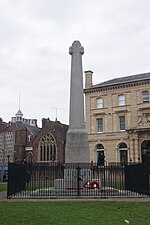Parliament Street, Exeter

Parliament Street is a 50-metre (160 ft)-long street in the city Exeter, Devon, England. It links High Street to Waterbeer Street and dates from the 14th century. About 0.64 metres (2 ft 1 in) at its narrowest and approximately 1.22 metres (4 ft 0 in) at its widest, it has been claimed to be the world's narrowest street, but this title officially belongs to the Spreuerhofstraße in Reutlingen, Germany.Formerly called Small Lane, it was renamed when Parliament was derided by the city council for passing the 1832 Reform Bill. It was called Parliament Alley, immediately after the name change from Small Lane. The authorities and some citizens thought an alley was "too common", so it was changed to Parliament Street circa 1850. Today it attracts tourists, many of whom have no idea that it is only an alleyway. In 1836 residents of nearby Waterbeer Street subscribed £130 to have Parliament Street widened, but this was not implemented.
Excerpt from the Wikipedia article Parliament Street, Exeter (License: CC BY-SA 3.0, Authors, Images).Parliament Street, Exeter
Parliament Street, Exeter St Thomas
Geographical coordinates (GPS) Address Nearby Places Show on map
Geographical coordinates (GPS)
| Latitude | Longitude |
|---|---|
| N 50.72304 ° | E -3.5323 ° |
Address
Parliament Street
Parliament Street
EX4 3DT Exeter, St Thomas
England, United Kingdom
Open on Google Maps











